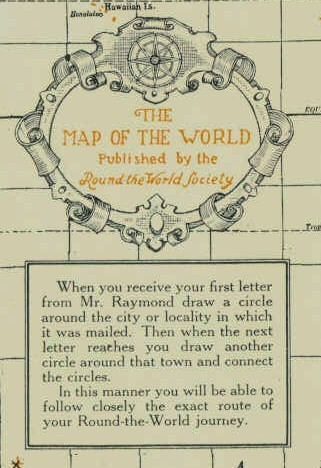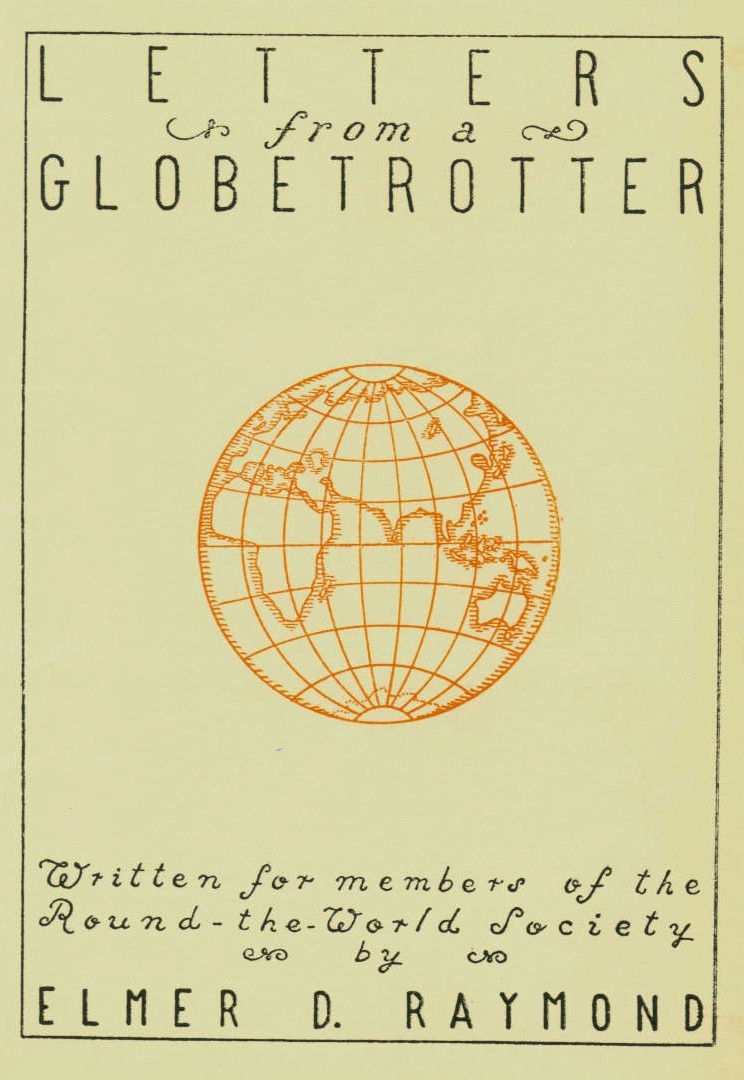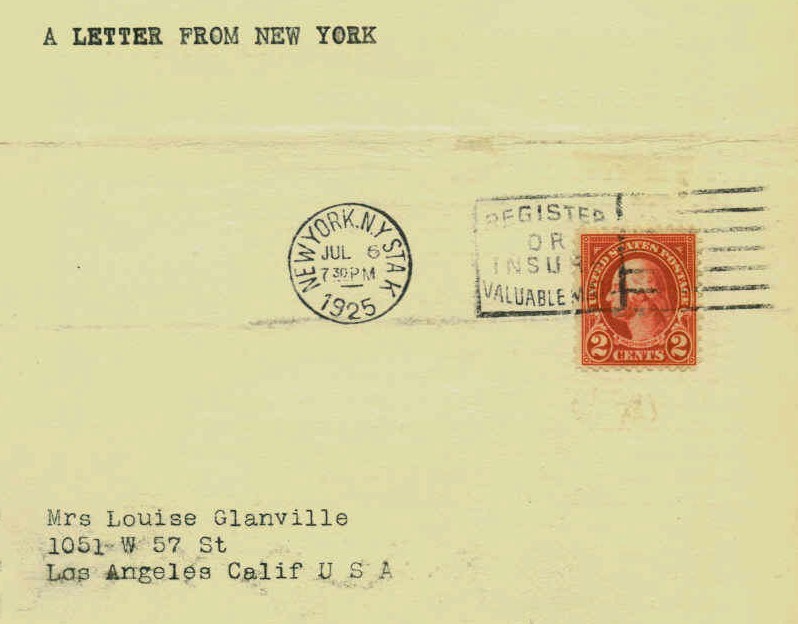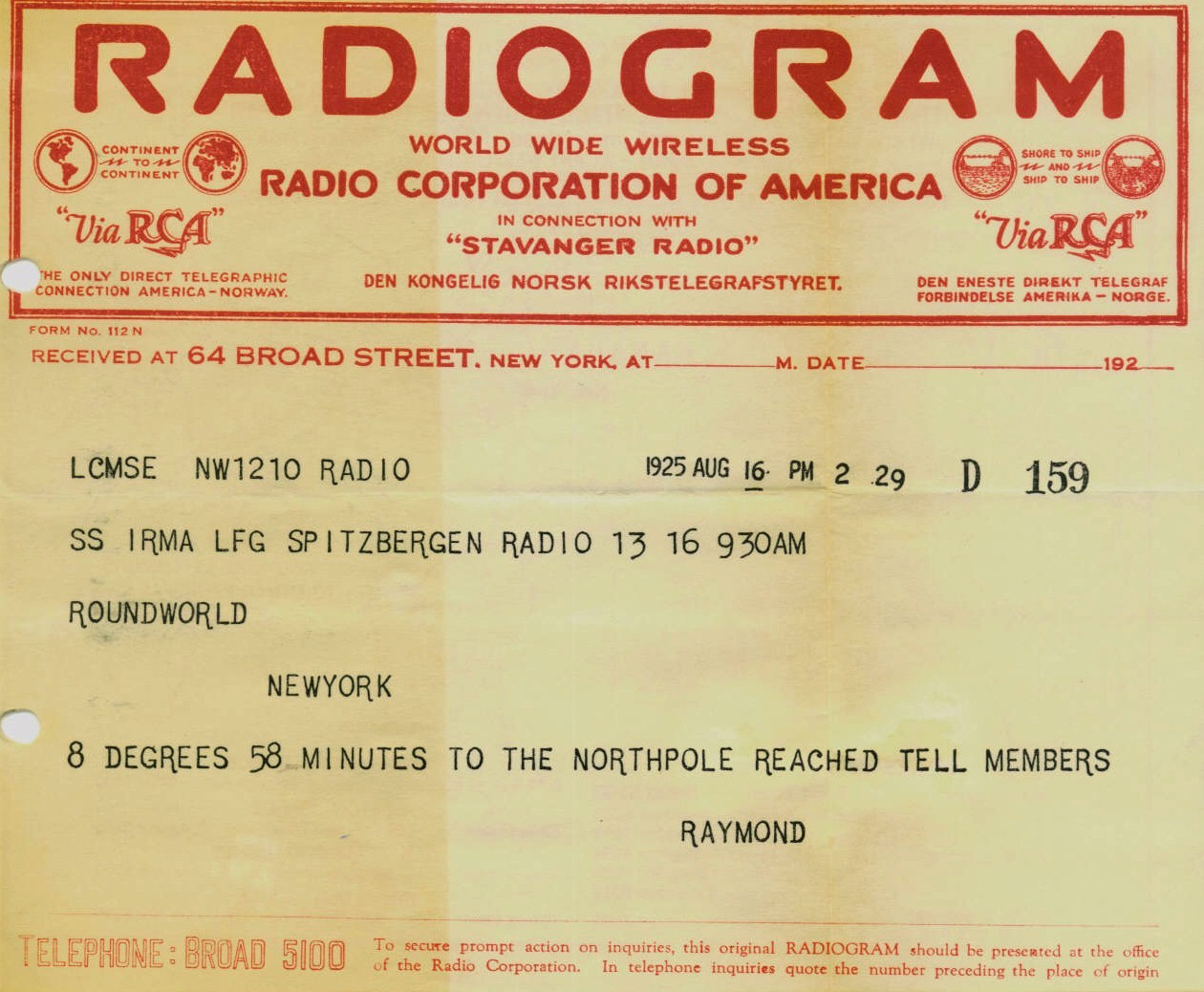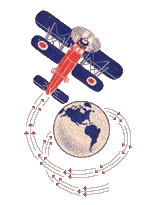As the 1920's proceeded there was an increasing interest in our shrinking
world where travel round-the-world would become possible for even the common man.
Elmer D Raymond formed the "Round-the-World Society" and became its leader calling
himself a "Globetrotter." He solicited subscribers who would receive detailed
travel letters sent by him as he globetrotted round-the world. These letters
would later be bound into books entitled, "Letters From a Globetrotter" and when
read would be an accurate commentary of the shrinking world as it existed in 1925
and 1926. These folded letters written by Raymond and sent to members of the
"Round-the-World Society" without envelopes but stamped and postmarked from the
visited countries would be compiled and saved and bound into volumes with inserts
and a pull-out map of the world.
Raymond began his journey from New York City on July 6, 1925 when he crossed
the Atlantic on a steamer bound for Southampton England. Some of his travel was
made by aeroplane and his flight from London to Paris is a factual commentary of
his flying experiences.
*********************************************************************************
Mid-air, En route to Paris.
Dear Friend:
When, the other day, in the Tower I beheld the jewels of the English crown,
I felt like Aladdin in the Treasure Cave. Then I took a celestial journey through
the telescope of the Observatory of Greenwich. Today I am seated on a magic carpet.
What is next?
After a short run the aeroplane took to wing. A steady motion gradually rising
upward, a curve, continuous climb, curve again, spiral maneuvers and suddenly I found
myself suspended betwixt sky and earth like the sarcophagus of Mohammed.
Glancing through the plate-glass window of the cabin in a horizontal direction,
my eyes caught no object on which to rest. Just air, clear, transparent air,
sparkling with joyous sunshine. Looking above me an ocean of blue greeted my eyes,
and in the endless blue white clouds floated lazily like dreamy ships shrouded in
mist. And down below? It was a sight which truly described would sound too fairylike
even for the stories of Alice in Wonderland.
The first thing that happened down there was the magic transformation of the
aerodrome. This big, bulky structure began to melt like a snow flake caught on a
warm window pane, and what remained of it was "but a child's tiny toy. As if in a
great excitement all the neighboring houses ran together, shrinking the big aerofield
into a spanful of yellow sand. More and more houses crowded upon each other in solid
formations and finally when I regained my breath, there below me lay the City of London,
like a gray town of dwarfs built on a field of green.
Now we are sailing gracefully above a sea of miniature gable-tops, flat roofs,
quaint steeples, cornices, spires and towers. Unlike the plans of American cities
where straight lines dominate, here is a multitude of winding streets zig-zagging in
a design which defies every law of symmetry and order. Capriciously these streets
turn hither and thither, till they meet in an unexpected point, or are swallowed by a
shapeless square. How can a Londoner ever find his way? It seems to me either he
never comes to know his city or he spends half his life to learn its peculiarities.
River Thames gleams like a dull gray metal ribbon. Bridges span its shoulders.
And right here before I forget it, I must notify all my little children-friends back
in the U.S.A. that the London Bridge is not, not and not falling down! There is the
Tower with its four-turreted keep, Piccadily Circus, Buckingham Palace. The little
black dots moving along the streets busily are not ants but human beings, most likely
splendid Englishmen. How can so much energy and determination be stored up in such
minute particles?
Heading toward the Channel. Green fields spotted with darker green trees. The
shadow of our aeroplane passes over the landscape like the shadow of a passing cloud.
Occasionally birds approach, then suddenly change course and flee. The land rapidly
rolls up below us like a multicolored carpet and simultaneously the blue Channel
unrolls with equal speed. Now we are right above the water. The Channel! I thought
its color would be gray, but it is a beautiful blue instead. A deep indigo with white
lining where the waves break on the yellow sandy shores.
I am thinking of the English fancy of "splendid isolation." Even recently the
plan for a tunnel under the Channel was drastically rejected. "While we are isolated,
we are safe." What would Wellington say seeing our strange machine hovering above his
beloved Channel?
A ship in sight. It is a small steamer ferrying passengers. As it scratches the
water it leaves a white mark on the surface, precisely like chalk drawn across a slate.
Soon shores bob up on the other side of the Channel. The French coast. Then comes the
patch-work of the French landscapes. Farms with fences around them and peaceful,
spotted cows on green meadows. Gaily colored clothes, hung to dry on rope lines
stretched between dwarf peach trees. A church and a walled-around church yard with
picturesque graves and monuments. Now we sail into a thin layer of misty cloud. The
landscape is vague and hazy. Out in the sunshine again. Above Amiens. The beautiful
Cathedral looks like a plaster model made for a museum. Nearby, on a little square,
there are small round spots of red and white; they are tent-umbrellas under which fruit
dealers are sitting and selling their goods.
It is a wonderful sensation to fly. Without a jerk or vibration one sails through
the air sitting in his soft upholstered chair. Speeding above cities, rivers, mountains,
the view is always varied and changes with kaleidoscopic rapidity. Getting near to Paris.
Villages look like honey combs. The Seine silvers in the green fields. Larger clusters
of houses. Suburbs. Then comes Paris. Descending. The field rapidly rises. Objects
grow. Houses develop. We are touching ground. A short run and a stop. As I step out
people greet me smiling and inquire:"How is everybody in London?" I reply: "How is
everybody in Paris?"
Of course my next letter I shall write from here. There are many beautiful things
in Paris and I am anxious to write you about them.
Cordially yours,
Elmer D. Raymond
***************************************************************************************
Letters from a Globetrotter - FOREWARD
In every age the lure of travel has captivated man's imagination. History has
been made, nations have been destroyed and created, a new world won through the
restless urge of man to adventure into the dark regions of the unknown.
We, today, still inherit this adventurous spirit of our forebears. In our blood
races the ancient desire to cast off the binding chains of business and home, and
to reach out for new lands that are to us as undiscovered worlds.
Yet after all travel in itself is but a momentary pleasure. The sensations we
obtain are but passing things; pictures that flash through the mind and disappear.
The most lasting value of travel is its memories which at the beckoning of the will
we may recall a thousand times over.
These fascinating memories it is that the Round-the-World Society brings you.
It is your ancient longing for the new and the strange that it satisfies. In
anticipation of the romantic trip that some day you will take; in pleasant remembrance
of the journey you may, perhaps, have already taken, the unique plan of the
Round-the-World Society offers you its greatest source of delight.
From the mighty metropolises of European civilization, from the squalid villages
of African savagery, from the icy wastes of the Arctic, from the barren sands of the
deserts, Elmer D. Raymond's letters will bring into your home the adventure that can
be equaled only by a personal visitation.
Each letter, in itself, will be a source of recurrent thrill. In your imagination
you can vision them speeding thousands, and tens of thousands of miles across oceans
and continents until they reach your home. They will come to you from great cities and
obscure hamlets in every corner of the earth, bringing most intimate impressions of
foreign lands and civilizations.
The romance of your letters, and their value too, is greatly enhanced by the
multi-colored foreign postage stamps. Your letters are written on the fashionable
"self-contained" stationery, in which the letter is its own envelope. Thus each letter
will have on its first page your name and address, the postage stamp, and the
cancellation mark showing the date and place of its origin.
Always as you read and reread your letters, which will finally fill this volume
from cover to cover, you will live again the golden hours of a most unusual journey.
This is what the membership in the Round-the-World Society really brings you. Visions,
unfading visions of glorious adventure that will always remain as a constant source
of joy and pride and romance.
